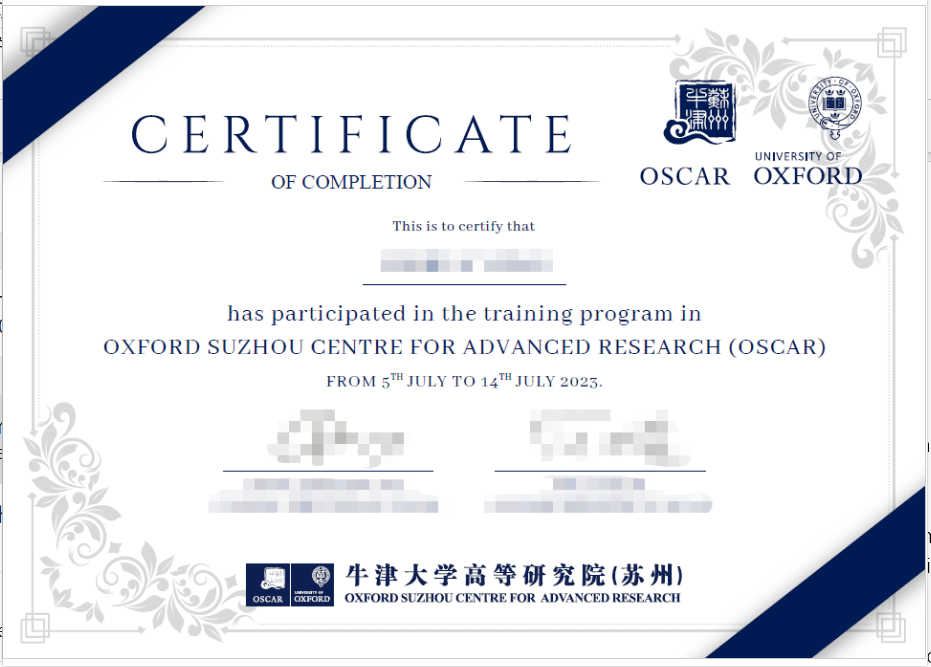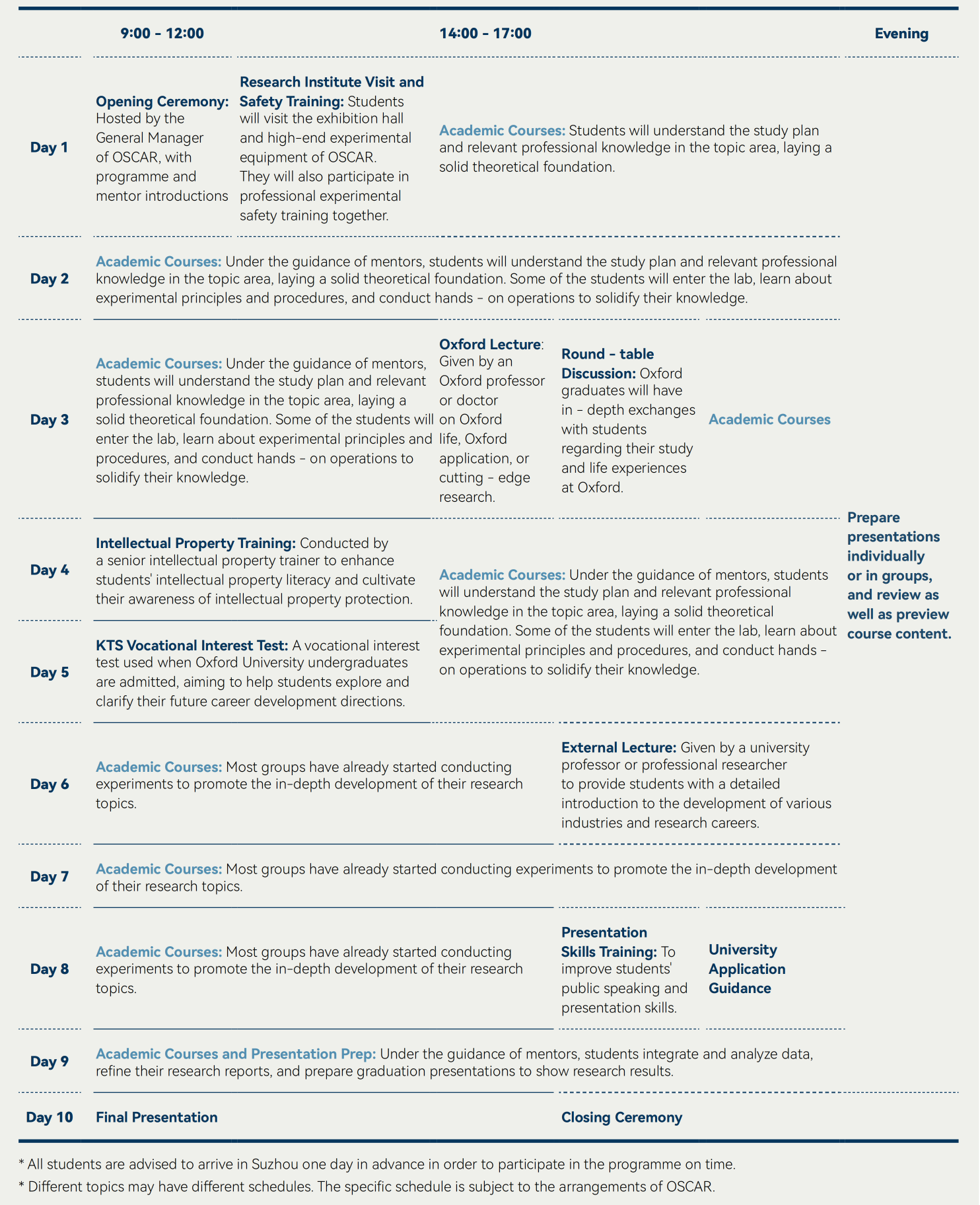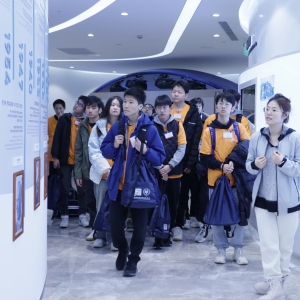Oxford STEM Winter School (Suzhou)

-
Oxford STEM Winter School (Suzhou)
Date:2nd-11th, February 2026 (10 days)
Optional Fields:Optoelectronics, Biotechnology, Low-carbon Energy, Medical Engineering, Business Innovation, Biochemistry
Tailored for:Students who are 16 years old and above before the programme starts
Location:Oxford Suzhou Centre for Advanced Research (OSCAR)
ApplyScan to Apply
Optional Fields
Optoelectronics
Biotechnology
Low-carbon Energy
Medical Engineering
Biochemistry
Business Innovation
— Introduction —
 Oxford STEM Winter School (Suzhou)
Oxford STEM Winter School (Suzhou)
The Oxford Suzhou Centre for Advanced Research (OSCAR) is the first overseas centre for physical sciences and engineering research set by the University of Oxford. OSCAR leverages the research strength of the University of Oxford as its foundation, spearheading research in modern biotechnology, advanced materials, computational methods, and manufacturing technologies to deliver innovative solutions for today's global challenges in healthcare, energy, environment, and finance.
In 2023, OSCAR and ASEEDER have entered into a strategic partnership to open the Oxford STEM Winter/Summer School (Suzhou) to outstanding high school students in China for the first time. The programme has successfully run for four sessions, with over 200 students admitted and participating in the programme, earning consistent praise from numerous students.
In the winter of 2026, the course will offer ten topics related to Optoelectronics, Biotechnology, Low-carbon Energy, Medical Engineering, Biochemistry, and Business Innovation. It is suitable for students applying from various majors, including physics, engineering, materials science, biology, medicine, chemistry, economics, and molecular biology.
— Why us —
Official
Official programme of Oxford. All the courses and topics are offered by the Oxford Suzhou Centre for Advanced Research (OSCAR). Students who fulfill the graduation requirements will be awarded an official certificate of completion.
All the courses will be conducted under the guidance of distinguished professors, scientists, and researchers from OSCAR. A restricted number of enrollment slots have been allocated for each topic, ensuring an ideal student-to-faculty ratio.
Distinguished Faculty
Top Topics
The programme is underpinned by the robust academic disciplines of the University of Oxford, providing ten elective topics in the domains of Optoelectronics, Biochemistry, Biotechnology, Low-carbon Energy, Medical Engineering, Business Innovation.
Through 10 days of in-depth study, students will complete personal academic output by combining their knowledge from the course and research after class.
Academic Output
Sophisticated Environment
Students will conduct real project research with academics from famous universities in real Oxford laboratories and project scenarios, and experience the world-class scientific research environment.
— Outcomes —
- Students who attend all the classes and meet all the requirements will receive a certificate of completion by OSCAR.
- Each student will produce an individual academic output in English.

Ten Topics
| Field | Topic | Quota | Major |
| Optoelectronics | Third-Generation Thin-Film Solar Cells | 8-10 | Physics, Electronic Science and Technology, Materials Science |
| New Light Source Based on Quantum Dots | 8-10 | Materials Science, Semiconductor Physics, Optics | |
| The Mystery of Intelligent Color-Changing: Electrochromic Technology | 8-10 | Materials Science, Physics, Electronic Engineering, Chemistry | |
| Biotechnology | Cutting-Edge Biotechnology to Address Health and Environmental Challenges: From AI Design to Biological Validation | 8-12 | Biology, Medicine, Molecular Biology, Environmental Sciences |
| Low-carbon Energy | Development of Membrane Electrode Process for Green Hydrogen Production | 6-10 | Chemistry, Materials Science |
| Medical Engineering | Future Frontiers in Regenerative Medical Technology and Tissue Engineering | 8-12 | Biology, Medicine |
| From Lab to Health Protection: Innovative Applications of Health from the ONE HEALTH Perspective | 6-10 | Biology, Medicine, Bioengineering, Global Health Science | |
| Biochemistry | Construction of a Fluorescent Protein Expression Plasmid to Label E.coli Cells | 5-6 | Biology, Chemistry, Molecular Biology |
| Directed Evolution of Enzyme via Site-directed Mutagenesis to Alter the Selectivity Towards Non-natural Substrate | 5-6 | ||
| Business Innovation | Oxford Tech Innovation Business Practice: Full-Process Operation of Commercialization for Early-Stage Tech Projects | 10-20 | Finance, Marketing, FinTech |
Click to view more
| Date:
02.02-02.11 (10 Days)| Tailored for:
Students who are interested in the development of solar energy technology with aspirations to study physics, engineering, or materials science.| Introduction:
Perovskite thin-film solar cells are a new generation of solar cell technology. Made using perovskite materials in a thin-film form, they offer many advantages, including high power-conversion efficiency, low manufacturing costs, light weight, and excellent flexibility. Perovskite thin-film solar cells can also be combined with traditional silicon solar cells to create tandem structures, further boosting energy-conversion performance. While perovskite thin-film solar cells are still evolving, they are advancing rapidly and hold great promise for future development.| Prospects:
Perovskite solar cells have wide-ranging applications in solar power generation, portable electronic devices, building integration, electric vehicles, and aerospace. Recognized as one of the top ten breakthroughs by the magazine "Science ", perovskite solar cells have been hailed as the most promising next-generation photovoltaic technology. Moreover, China has successively released 9 policies and documents related to perovskite from 2019, with 7 policies issued since 2022, emphasizing efforts to promote the standardization of perovskite photovoltaic cells.| Theoretical Part:
- The basic principles and composition of solar cells
- The characteristic structure and preparation methods of perovskite materials
- The manufacturing process and technical route of perovskite thin - film solar cells
- The advantages and disadvantages of perovskite thin - film solar cells
- Application cases and prospects of perovskite thin - film solar cells
- Gain deep insight into daily scientific research practice through observation and interaction with frontline researchers
- Conduct paper-reading and complete literature reviews on scientific questions
| Practical Part:
- Solar cell prep.: Fabricate thin - film materials, conduct electrode deposition.
- Test solar cell electric props.: I - V characteristic charact. exp.
- Evaluate solar cell PEC efficiency: EQE charact. & analysis exp.
- Analyze material crystal structs.: XRD measurement demo exp.
- Observe material surface & micro structs.: SEM measurement demo exp.
| Date:
02.02-02.11 (10 Days)
| Suitable Students:
Students who are interested in solid-state physics, semiconductor physics and devices, and nanomaterials science, and who plan to apply for related majors such as physics, electronic science and technology, or materials science in the future.
| Introduction:
This course integrates theoretical instruction with experimental practice to provide a comprehensive understanding of QLED fundamentals, key performance metrics, and potential applications. Through a combination of lectures, discussions with researchers, and hands-on experiments, participants will develop analytical skills, gain exposure to frontier research, and receive guidance for academic and professional development.
| Prospects:
Quantum dots are 1-100 nanometer semiconductor nanocrystals with strong quantum confinement. After winning the 2023 Nobel Prize, quantum dot tech has advanced fast. Colloidal quantum dots are popular for their tunable emission, narrow-band light, and high efficiency. QLEDs, based on quantum dots, have great potential due to high efficiency, low cost, and flexibility. They're widely used in lighting, display, communication, AR/VR, medical imaging, and next-gen quantum optics. For instance, in displays, quantum dot tech improves quality and color saturation. Mordor Intelligence predicts the quantum dot market will grow from $64.9 billion in 2025 to $144.8 billion in 2030, with a 17.4% CAGR.
| Theoretical Part:
- The fundamentals of semiconductor physics
- Basic structure and key performance parameters of QLEDs
- Quantum dot material properties & application prospects
- Insights on frontier research from front-line researchers
- To develop the ability of scientific research and literature review, and to be able to analyse the key scientific issues of new light sources
- Oxford prof.'s speech on new optoelectronic devices
| Practical Part:
- Prepare films by solution & vacuum evaporation
- Test photophysics of quantum dot films
- Fabricate red quantum dot LEDs
- Measure LED electricals (I - V - L - E)
- Analyze key performance factors (fluorescence, coupling)
- Observe dot films under photo/electro - excitation
| Date:
02.02-02.11 (10 Days)| Suitable Students:
Students who are interested in electrochromic technology, and intelligent materials , and who plan to apply for related majors such as materials science, chemistry, physics, and electronic engineering in the future.| Introduction:
The course combines systematic theory and hands-on experiments. Students will master the fundamentals of electrochromic technology—from core principles and device structures to material properties, fabrication processes, and multi-field applications through real world cases. Hands-on lab sessions provide firsthand experience: preparing polymer films, assembling devices, and analyzing optical/electrical performance, while comparing electrochromics with other smart window technologies.| Prospects:
Electrochromics is an emerging cross-disciplinary field where applied voltage reversibly alters material color. With advantages like low energy use and visual comfort, it is transforming architecture, transportation, displays, and wearables. Examples include: energy-saving adaptive windows, auto-dimming rearview mirrors, and Xiaomi’s YU7 Max panoramic roof with 99.99% UV/IR blocking. The technology—integrating materials science, chemistry, physics, and electronics—is a global research focus and key to future smart materials and sustainability.| Theoretical Part:
- Fundamentals of Electrochromic Technology: Understand the interdisciplinary nature, the core principles of reversible color change under low voltage, device structure, and basic device operation
- Electrochromic Materials: Study properties, advantages, and limitations of major electrochromic materials
- Applications & Case Analysis: Analyze uses in real-world applications in smart windows, low-power displays, sensors, and wearable devices (e.g., Color-changing phone case, Xiaomi YU7 sunroof)
- Comparison & Trends: Compare electrochromic with other "smart window" technologies, objectively assessing its advantages, challenges, and future trends
- Frontiers & Prospects: Learn the latest advances, global research focus of electrochromic technology, and its broad prospects
| Practical Part:
- Film Preparation: Preparation of polymer electrochromic films, mastering key fabrication steps, safety, and operational protocols
- Device Assembly: Practice assembling simple electrochromic devices, applying structural knowledge to realworld applications
- Performance Characterization: Use specialized instruments to test optical (e.g., transmittance, colour shift) and electrical properties (e.g., voltage response, stability); learn to interpret data
| Date:
02.02-02.11 (10 Days)
| Suitable Students:
Students who are interested in biotechnology, microbiology, and the AI application in the biological field, and who plan to apply for interdisciplinary studies (microbiology, bioengineering, computational science).
| Introduction:
Microorganisms are ubiquitous, playing positive roles for humans, the entire biosphere, and Earth's atmosphere. However, certain pathogenic bacteria and viruses can cause various human infectious diseases. This course will guide students to explore how microbes serve as key tools in addressing critical needs such as antibiotic resistance, health surveillance, disease diagnosis, and microbially-driven carbon fixation, and to systematically discuss how to leverage AI for designing innovative technologies followed by biological validation.
| Prospects:
Following the COVID-19 pandemic, there is a growing realisation that microbes are the foundation of the biosphere. They are the ancestors of all living organisms and the support system for all other life forms. This project addresses urgent challenges in health (e.g., infectious diseases, antibiotic resistance) and the environment (e.g., carbon fixation). The microbial industry is a national strategic emerging industry, supported by China’s medium- and long-term science and technology development plans and the 13th Five-Year Bio-technology Innovation Initiative.
| Theoretical Part:
- The important role, unique advantages, and dual nature (beneficial vs. pathogenic) of microorganisms in addressing major health and environmental challenges
- Essential biotechniques, including molecular cloning and PCR
- The critical function of Raman spectroscopy in biological signal detection
- Applications of biosensors in disease diagnosis and environmental monitoring
- Core concepts, tools, and case studies of AI in biological design, with a focus on microbiology
- Interdisciplinary thinking from microbiology, bioengineering, and computational science to analyze complex problems
| Practical Part:
- Molecular cloning and PCR experiments
- Applications of Raman spectroscopy in biological signal detection
- Biosensor experiments for disease diagnosis and environmental monitoring
- Develop fundamental practical skills for biological research
| Date:
02.02-02.11 (10 Days)
| Suitable Students:
Students who plan to apply for majors in Chemistry / Material Science / Chemical Engineering in the future.
| Involving Fields:
Chemistry (electrochemistry, inorganic chemistry), Materials Science (nanomaterials, new energy materials, materials chemistry, materials characterization), Engineering (green chemical engineering, fine chemical engineering)
| Introduction:
This course is designed for beginners passionate about chemistry, materials science, or chemical engineering to explore how modern chemical and materials science develops innovative materials and devices to address challenges in green hydrogen production. Key learning outcomes include understanding the structural design and fabrication methods of MEAs in PEM water electrolysers, as well as testing and comparing the performance of different MEA component configurations.
| Prospects:
Green hydrogen is regarded as the ultimate energy source. Especially against the backdrop of challenges in addressing climate change and reducing greenhouse gas emissions, green hydrogen is receiving increasing attention. Green hydrogen relies on renewable energy sources such as wind energy, solar energy, and hydropower, and uses water electrolysis or thermolysis technology to produce hydrogen. The entire hydrogen production process does not emit carbon dioxide, achieving zero carbon emissions. The global demand for green hydrogen is also growing rapidly, reaching approximately 70 million tons in 2030. Therefore, the world is vigorously developing green hydrogen - related technologies, especially the production of green hydrogen, which is the basis, core, and difficulty of hydrogen energy technology. Currently, hydrogen energy has been applied in multiple fields such as transportation, industry, and energy, such as hydrogen - fuel - cell vehicles and hydrogen - fuel - cell buses.
| Theoretical Part:
- Thermodynamics & kinetics of water electrolysis for hydrogen production
- Structure and design principles of hydrogengenerating MEAsrs
- Membrane electrode structure & preparation
- Catalyst synthesis in membrane electrodes: methods comparison
- Catalyst physical structure characterization: methods & principles
- Catalyst electrochemical performance testing: methods & principles
| Practical Part:
- Synthesize target catalysts via liquid - phase and sintering methods.
- Characterize catalyst structures using XRD, SEM, etc.
- Prepare coating slurries with catalysts according to ratios.
- Operate a flat - plate coater to coat catalyst slurry electrodes.
- Analyze the morphology of fabricated membrane electrodes with a high - resolution optical microscope.
- Evaluate the hydrogen - production performance of membrane electrodes.
| Date:
02.02-02.11 (10 Days)
| Suitable Students:
Students who are interested in scientific exploration in biomedicine, with aspirations to study molecular biology, materials science or biomedicine.
| Introduction:
Regenerative medicine is a broad multidisciplinary field that includes tissue engineering and biomaterials but also incorporates research on self-healing, whereas the body uses its own systems and defenses to recreate cells and rebuild tissues and organs. This intensive course offers a fantastic opportunity to learn and experience in the fields of regenerative medicine and biomedical engineering, which have been designed specifically for individuals with a strong interest in cutting-edge scientific research. You will gain firsthand experience in the multidisciplinary nature of regenerative medicine, engaging in both observational learning and hands-on activities alongside leading researchers. The course covers a broad spectrum of topics, from cell culture and molecular biology techniques such as PCR to the design and creation of functional materials and bioreactors through 3D printing and computer-aided 3D design. By actively participating, students will deepen their understanding of bioengineering principles and regenerative medical technologies, helping them to refine their academic interests and make informed decisions about their future studies.
| Prospects:
In many blockbuster movies, we often see scenes where severely injured individuals rapidly heal and wounds miraculously regenerate thanks to advanced medical technology. Today, such science fiction scenarios are gradually becoming a reality. American biologist and Nobel laureate Gilbert predicts that within 50 years, humans will be able to cultivate all organs of the body. This transformation is attributed to regenerative medicine. In China, regenerative medicine has been included as a critical research area in the "13th Five-Year Plan for Health and Medical Technology Innovation", aiming to accelerate the clinical application and translation of regenerative medicine and other biological therapies, thereby enhancing China's originality in the forefront of medical research.
| Theoretical Part:
- Primer design for Polymerase Chain Reaction (PCR)
- Molecular biology (DNA/RNA, genome)
- Principles and applications of 3D printing technology
- Cell biology: Studying the basic laws of life activities at the cellular level
- Concept and applications of cold plasma
- Engage in Cutting-Edge Research Activities: Observe and interact with researchers to understand the methodologies and approaches used in leading scientific research
- Explore Future Academic Pathways: Reflect on the hands-on experiences and interdisciplinary knowledge gained to help guide your future academic and career decisions
| Practical Part:
- Training on the use of pipettes and microscopes
- PCR experiments: Covering processes such as DNA isolation, amplification, gel electrophoresis and imaging
- Preparation of silk membranes using electrospinning technology
- Design and assembly of 3D bioreactors
- Cell culture experiments
| Date:
02.02-02.11 (10 Days)
| Suitable Students:
Students who are interested in biotechnology, public health, medicine (human / animal), environmental science, and with aspirations to develop scientific thinking and want to study global health and biomedicine-related areas in the future.
| Introduction:
ONE HEALTH is a global health perspective that emphasizes the close connection between human, animal, and environmental health. This course provides a platform for students to explore the forefront of biotechnology and cultivate scientific research thinking. Students will learn molecular diagnostics, biomarker detection, and bioproduct preservation and processing techniques, preparing them to be innovative and practical scientists capable of addressing global health challenges.
| Prospects:
Endorsed by major organizations including WHO, FAO, WOAH, and UNEP, One Health is integral to global public health strategy. This approach offers broad application prospects in addressing critical global health issues. For example, in controlling zoonotic diseases like avian flu and brucellosis, molecular diagnostics enable rapid traceability of transmission chains, while biomarker detection allows early identification of health anomalies. It also helps assess combined risks of contaminants such as heavy metals in soil and microplastics in water, informing effective interventions. Now a cornerstone of global public health—evidenced in WHO’s animal-environmental emphasis during COVID-19—One Health equips students with valuable skills for interdisciplinary research, international health cooperation, and biomedical industries, growing in relevance as global health gains priority.
| Theoretical Part:
- Theoretical Knowledge: Understand the ONE HEALTH concept and its application in public health. - Master the basic principles of molecular diagnostics, biomarker detection, and bioproduct processing techniques.
- Practical Skills: Be able to independently complete molecular diagnostics and biomarker detection experiments.
- Global Health & Social Responsibility: Recognize the important role of science and technology in promoting human and animal health and protecting the environment. - Enhance students' sense of social responsibility and awareness of participating in global health governance.
| Practical Part:
- Molecular Diagnostics: Nucleic acid extraction and PCR amplification independently following protocols and safety standards
- Biomarker Detection: Sample preparation, reagent application, and basic interpretation
- Innovative Application: Design solutions in simulated scenarios (e.g., zoonotic disease testing) to develop critical thinking and interdisciplinary collaboration.
| Date:
02.02-02.11 (10 Days)
| Suitable Students:
Students who are interested in biochemistry, and with aspirations to learn biology, chemistry, and molecular biology in the future.
| Involving Fields:
Introduction to Molecular Biology | Polymerase Chain Reaction | Recombinant Protein Expression Experiment
| Introduction:
This course will introduce a range of fundamental experimental techniques widely utilized in modern biological research. In the technical background introduction, we will cover the use of Polymerase Chain Reaction (PCR) for DNA amplification, the use of Restriction Endonucleases and Gibson Assembly technology for the construction of extracellular DNA plasmids, what is plasmid transformation and the expression of recombinant genes, as well as the pivotal role and significance of Escherichia coli in modern biological research. You will have the opportunity to delve into the discovery processes and technical principles behind many basic experimental techniques and learn how to integrate different experimental techniques to conduct comprehensive experimental explorations on a research subject.
| Prospects:
While cloning may evoke images of Dolly the sheep or science fiction, molecular cloning is now broadly applied—copying DNA from one cell into another for clinical diagnostics (e.g., genetic disease or cancer analysis) and genetic engineering (e.g., GMOs).
| Date:
02.02-02.11 (10 Days)
| Suitable Students:
Students who are interested in biochemistry, and with aspirations to learn biology, chemistry, and molecular biology in the future.
| Involving Fields:
Introduction to Molecular Biology | Basic Knowledge of Biological Enzymes | Principles of Artificial Mutation of Enzymes | Analytical Methods for the Results of Enzymatic Catalytic Reactions
| Introduction:
Enzymes are the catalysts for various metabolic reactions in living organisms. With their diverse functions, enzymes can drive efficient biochemical reactions, including energy provision, body growth and repair, resistance to, and degradation of exogenous toxic substances. In industrial production, enzymes serve as highly efficient and specific biocatalysts. Many complex compounds are difficult to produce through chemical synthesis, but intricate yet sophisticated biological enzymes can often achieve the desired chemical reactions efficiently and precisely under mild and simple reaction conditions. In this course, you will have the opportunity to learn the fundamentals of biological enzymes, including the relationship between protein structure and function. You will discover how DNA expresses a fully functional enzyme and how modifying the gene sequence can influence and regulate enzyme function. Additionally, you will gain insights into experimental methods used in modern enzyme engineering research to measure enzyme catalytic reaction yields and selectivity.
| Prospects:
Many metabolic disorders, such as albinism (caused by a deficiency in tyrosine hydroxylase), are linked to enzyme dysfunction. In 2018, Frances Arnold won the Nobel Prize in Chemistry for pioneering the directed evolution of enzymes, allowing humans to “steer evolution.” Enzymes developed through this method are now used to produce biofuels, pharmaceuticals, and more. “Repurposing enzymes for new applications” remains a highly active research area in chemistry.
| Date:
02.02-02.11 (10 Days)
| Suitable Students:
Students who are interested in the intersection of technology and business, and with aspirations to understand tech commercialization, explore entrepreneurship, learn how technologies in healthcare, energy, and smart devices are productized, or develop foundational skills in business analysis and project management as preparation for future studies in business or economics.
| Introduction:
This course will be customized based on Oxford University's experience in incubating early science and technology projects in China, with a focus on the analysis of technology transfer pathways for young innovators. You will have the opportunity to learn about the latest technologies in biomedicine (medicine, diagnosis, instruments), energy (energy saving, power generation, storage), information and communication technology, and intelligent manufacturing (robots, automation equipment). Through this course, you will learn about successful cases of foreign advanced technologies being commercialized in China, and the opportunity to communicate face-to-face with the founders of early incubation projects as well.
| Prospects:
With deepening integration between technology and business globally, there is a growing demand for talents who understand both domains. This course helps students build practical skills in tech project analysis, market research, and IP management—preparing them for future tech ventures, business roles in technology sectors, or further studies in business and economics. As a leader in the field, the University of Oxford has achieved notable success in technology commercialization, having founded over 300 companies in cutting-edge areas such as life sciences and AI. A prime example is Oxford Nanopore Technologies, a pioneer in gene sequencing. Through Oxford University Innovation (OUI), the university continues to drive realworld impact, spinning out 15 new companies in 2024 alone and attracting substantial external investment. It also receives significant funding from UK Research and Innovation (UKRI), underscoring its strong commitment to applied technology and providing authoritative case studies for this course.
| Content:
- Learn to conduct initial analysis of early-stage tech projects in analyst and project management roles, supporting the incubation of spin-off companies
- Collect, analyze, and manage intellectual property information for early-stage start-up companies
- Conduct market analysis and data collection for target incubation companies
- Improve project information management efficiency by creating and managing project plans and schedules as well as writing project progress reports
- Understand the components of a tech project pitch, and complete a mini pitch based on a real-life case study
Sample Schedule

Programme Information
Location:
Oxford Suzhou Centre for Advanced Research (OSCAR)
Language:
English and Chinese
*During laboratory practical sessions, instructors will provide instruction in both Chinese and English to assist students' understanding. Students who participate are required to have good English reading skills and be able to complete the graduation assignments in English (such as English academic presentations, short English experimental reports, etc.).
Eligible Age:
Applicants must be at least 16 years old by February 2, 2026, i.e., their date of birth must be on or before February 2, 2010.
*If an applicant does not meet the age requirement for a specific topic, they must send the following information to ASEEDER teachers: 【Date of Birth + Intended Topic + Available Interview Time Slots (e.g., 7:00 PM-9:00 PM on weekdays)】, and the research group tutors will conduct an online interview for assessment.
English materials required before the interview:
- A cover letter stating your motivation for joining the program
- A one-page CV
- Current language proficiency proof
After passing the interview, students are exempted from the January-February group meetings.
Requirements:
-
- Obtain grade B in ASDAN EPQ related research
- English language level equivalent to IELTS level 6.0 or TOEFL 80, and grade A or a score of 7 in (I)GCSE related subjects
- If you do not meet the above criteria, you will be required to do a phone or an online interview in English with an ASEEDER teacher
* All students will have an online group meeting with their project mentors in January or February.
Fee:
【Includes】Tuition, Certificate application, Teaching facility costs, Laboratory equipment and instrument usage, ASEEDER group leader service fee, Insurance
【Excludes】Round-trip transportation costs, food costs and accommodation (ASEEDER logistics service is available for students.)





















